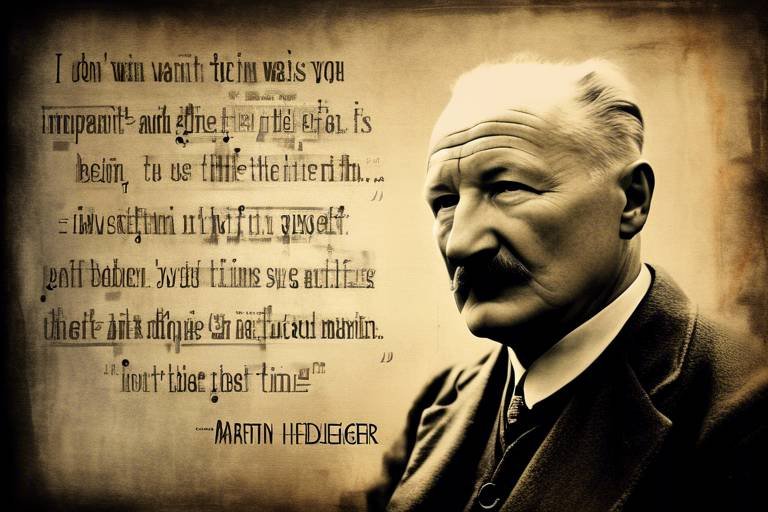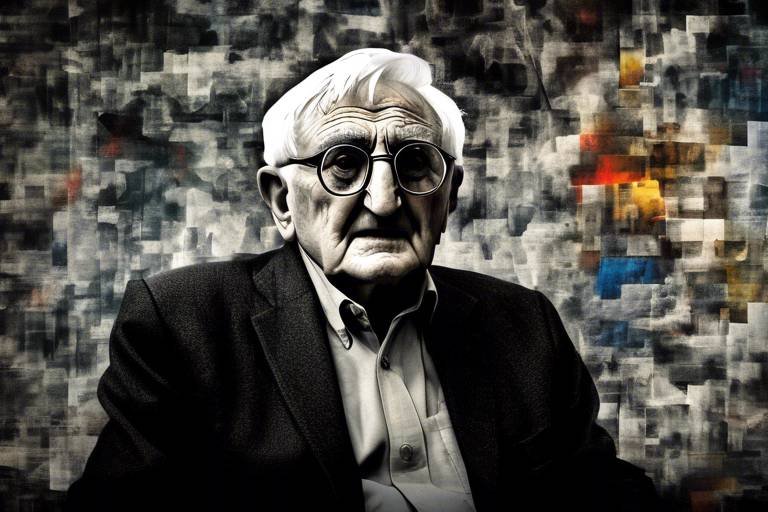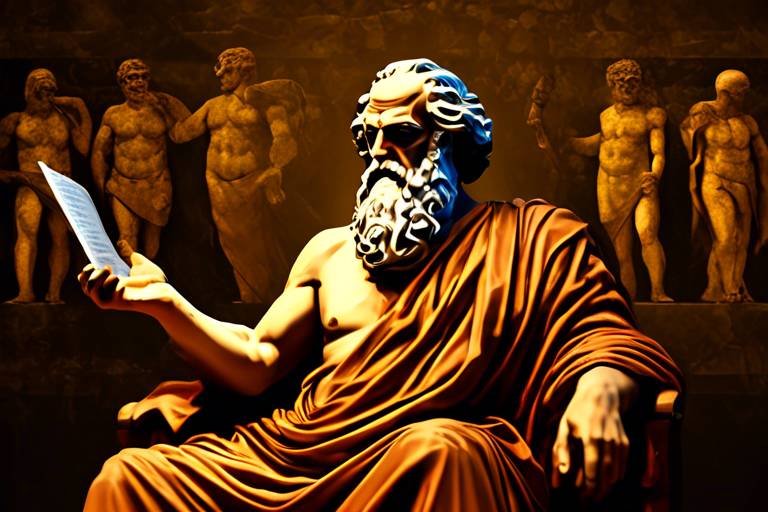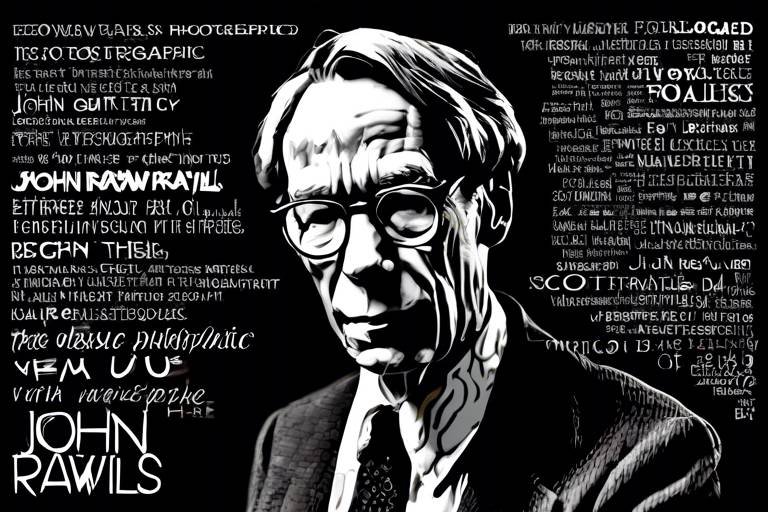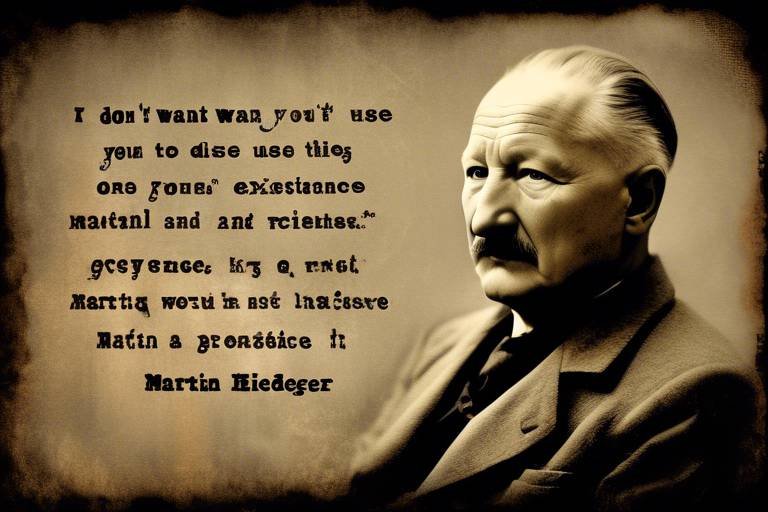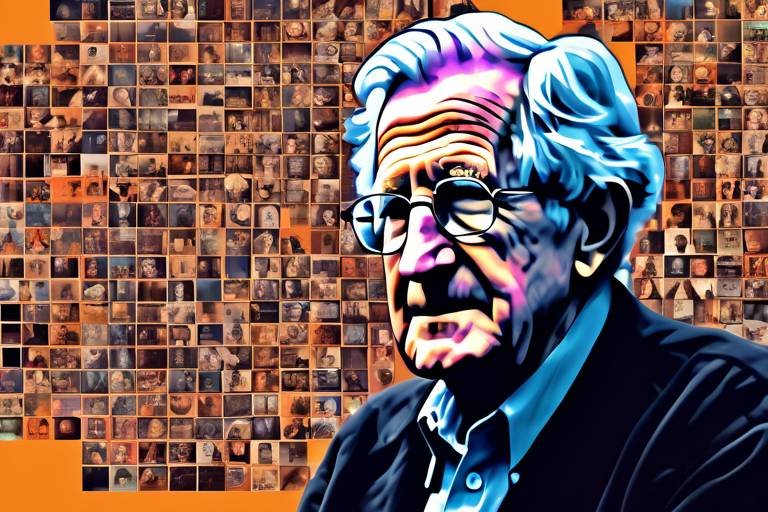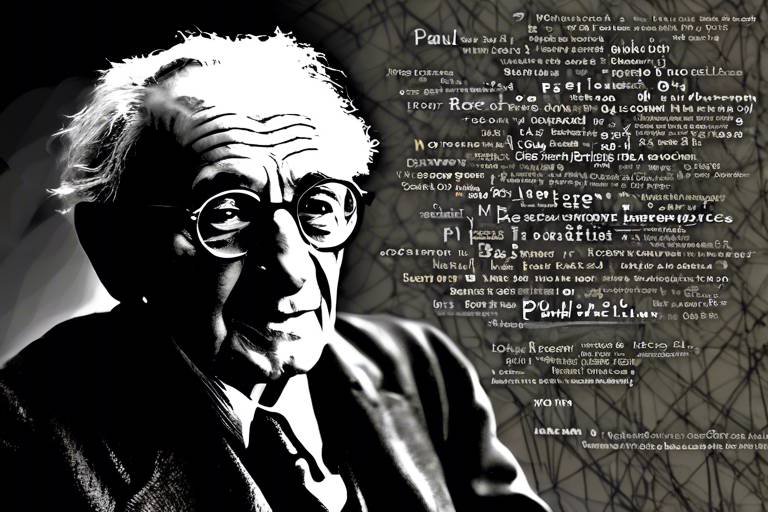Martin Heidegger's Being and Time - A Brief Analysis
This article explores the key themes and concepts of Martin Heidegger's seminal work, Being and Time, highlighting its significance in existential philosophy and its impact on contemporary thought.
Published in 1927, Being and Time is often regarded as one of the most important philosophical texts of the 20th century. Martin Heidegger, a German philosopher, crafted this work during a period marked by profound existential questions stemming from the aftermath of World War I. His inquiry into the nature of being was not merely academic; it resonated deeply with the uncertainties of modern life. Heidegger sought to address the essence of existence, which he believed had been overlooked in the history of Western philosophy. This work serves as a foundational pillar in existential philosophy, influencing thinkers like Jean-Paul Sartre and Maurice Merleau-Ponty, and continues to be a touchstone in modern philosophical discourse.
At the heart of Being and Time lie several central themes that are pivotal to understanding Heidegger's philosophical inquiry. Among these, the concept of Being itself takes center stage. Heidegger argues that to truly grasp the meaning of being, one must first examine the nature of Dasein, a term he uses to describe human existence. This exploration leads to a profound understanding of how we relate to our world and the beings within it. The text is rich with insights that challenge us to rethink our everyday experiences and the very fabric of reality.
Dasein, which translates to "being-there," is a foundational element of Heidegger's analysis. It signifies the unique mode of existence that characterizes human beings. Unlike other entities, Dasein is self-aware and capable of reflection, which allows it to question its own existence. This self-awareness brings with it a sense of responsibility and freedom, as individuals must navigate their own paths in a world filled with choices and uncertainties. By understanding Dasein, we can better comprehend the intricate relationship between our existence and the world around us.
Heidegger's notion of being-in-the-world emphasizes that our existence is not isolated; rather, it is deeply intertwined with our environment and the people we interact with. This concept challenges the Cartesian idea of a detached thinker, suggesting instead that we are always engaged with the world. Our experiences, emotions, and actions are shaped by this interconnectedness, illustrating that our understanding of reality is a shared phenomenon. The implications of this idea are vast, as it urges us to consider how our relationships and surroundings influence our identity and understanding of existence.
Heidegger further distinguishes between authenticity and inauthenticity in our existence. Authenticity involves recognizing one's own potential and making choices that reflect one's true self, while inauthenticity entails conforming to societal norms and expectations, often leading to a sense of disconnection from one's own being. This dichotomy raises essential questions about personal freedom and responsibility. Are we living authentically, or are we merely going through the motions dictated by external pressures? By confronting these questions, Heidegger encourages us to take ownership of our existence.
Another critical aspect of Being and Time is Heidegger's exploration of time and temporality. He posits that our understanding of being is inherently linked to our experience of time. Unlike the traditional view of time as a linear progression, Heidegger suggests that time is more complex and intertwined with our existence. The past, present, and future are not merely sequential; they are interconnected dimensions that shape our understanding of ourselves and our place in the world. Recognizing this can lead to a deeper appreciation of how our historical context and future possibilities influence our current experiences.
The impact of Being and Time on various philosophical movements cannot be overstated. It has significantly influenced existentialism, phenomenology, and even postmodern thought. Philosophers and scholars continue to engage with Heidegger's ideas, debating their implications and applications in contemporary discussions. The text invites readers to reflect on their own existence, urging them to consider the deeper meanings behind their everyday experiences.
Despite its profound influence, Being and Time has faced numerous critiques and diverse interpretations. Some argue that Heidegger's ideas are overly abstract and difficult to apply to real-life situations. Others have challenged his views on authenticity and the implications for individual freedom. Nevertheless, these critiques have sparked rich discussions and have led to a variety of lenses through which scholars have approached his work, ensuring that Heidegger's legacy remains a topic of vibrant debate.
Reflecting on the legacy of Martin Heidegger's philosophy, it is clear that Being and Time continues to inspire and provoke thought in modern philosophical discussions and beyond. Its exploration of existence, time, and the nature of being resonates with contemporary issues, encouraging individuals to examine their lives and the world around them critically. As we navigate an increasingly complex reality, Heidegger's insights remain relevant, urging us to confront the fundamental questions of existence.
- What is the main idea of Being and Time?
The main idea revolves around the exploration of existence, particularly through the concept of Dasein, which refers to human beings as beings that are aware of their own existence.
- How has Being and Time influenced modern philosophy?
It has significantly impacted existentialism, phenomenology, and postmodern thought, shaping discussions around authenticity, freedom, and the nature of reality.
- What does Heidegger mean by authenticity?
Authenticity refers to living in accordance with one's true self and potential, as opposed to conforming to societal expectations.

Being and Time,
This article explores the key themes and concepts of Martin Heidegger's seminal work, Being and Time, highlighting its significance in existential philosophy and its impact on contemporary thought.
Published in 1927, Martin Heidegger's Being and Time revolutionized the landscape of philosophy. Set against the backdrop of a world grappling with the aftermath of World War I, this work was a response to the disorientation of modern existence. Heidegger sought to tackle the fundamental question of what it means to "be." This inquiry laid the groundwork for existential philosophy, influencing thinkers across various disciplines. Even today, Being and Time remains a cornerstone of philosophical discourse, challenging us to reconsider our understanding of existence and our place in the world.
At the heart of Being and Time are several key themes that intertwine to form a complex tapestry of thought. Central to Heidegger's inquiry is the concept of Being, which he argues has been overlooked in philosophical discussions. This leads to his exploration of Dasein, a term he uses to describe human existence. Dasein is not just a being that exists; it is a being that is aware of its existence and constantly questions it. Through this lens, Heidegger delves into the nature of existence, challenging readers to confront their own being.
Dasein, which translates to "being-there," is a pivotal concept in Heidegger's philosophy. It encapsulates the idea that human beings are not isolated entities; rather, they exist in a world filled with relationships and meanings. Dasein is characterized by its ability to reflect on its own existence and engage with its surroundings. This self-awareness is what distinguishes humans from other beings. Heidegger argues that understanding Dasein is essential for grasping the essence of Being. It compels us to ask: What does it mean to truly exist?
Heidegger introduces the notion of being-in-the-world to illustrate how our existence is fundamentally intertwined with our environment and the people around us. This concept emphasizes that we are not detached observers; instead, our experiences are shaped by our interactions with the world. Think of it like a fish in water—its existence is defined by the very environment it inhabits. This interconnectedness influences our understanding of reality, as we navigate through a web of relationships and meanings that contribute to our sense of self.
Another crucial aspect of Heidegger's thought is the distinction between authenticity and inauthenticity. Authenticity refers to living in accordance with one's true self, making choices that resonate with one's own values and beliefs. In contrast, inauthenticity arises when individuals conform to societal expectations, losing sight of their own identity. This struggle for authenticity raises important questions about personal freedom and responsibility. Are we merely products of our environment, or can we carve our own paths?
Time is a fundamental theme in Being and Time, where Heidegger explores the significance of temporality in shaping human existence. He argues that our understanding of time is not linear; instead, it is a complex interplay of past, present, and future. Our history informs our present actions, while our future possibilities shape our current decisions. This temporal dimension is crucial for grasping the essence of Dasein. By recognizing our place within this temporal framework, we can better understand our existence and the choices we make.
Being and Time has had a profound impact on various philosophical movements, including existentialism, phenomenology, and postmodern thought. Its exploration of existence and human experience resonates with contemporary debates on identity, meaning, and the human condition. Philosophers and thinkers have drawn from Heidegger's ideas to challenge traditional notions of reality, prompting a reevaluation of what it means to be human in today's complex world.
Despite its significance, Heidegger's work has faced critiques and diverse interpretations. Scholars have debated the clarity of his writing and the implications of his ideas. Some argue that his concepts are overly abstract, while others find them deeply relevant. The various lenses through which his work is approached highlight the richness and complexity of his philosophy, inviting ongoing discussion and exploration.
The legacy of Martin Heidegger's philosophy is enduring, as Being and Time continues to inspire and provoke thought in modern philosophical discussions and beyond. His exploration of existence, time, and authenticity resonates with contemporary issues, urging us to confront our own being and the world around us. As we navigate the complexities of life, Heidegger's insights remain a guiding light, challenging us to live authentically and engage deeply with our existence.
- What is the main idea of Being and Time?
The main idea revolves around the question of what it means to "be," exploring human existence through the concept of Dasein and its relationship with time and authenticity.
- Why is Dasein important?
Dasein is crucial because it represents human beings as self-aware entities that engage with their world, allowing for a deeper understanding of existence.
- How has Being and Time influenced modern philosophy?
The work has significantly impacted existentialism, phenomenology, and postmodern thought, prompting new discussions about identity and the human experience.
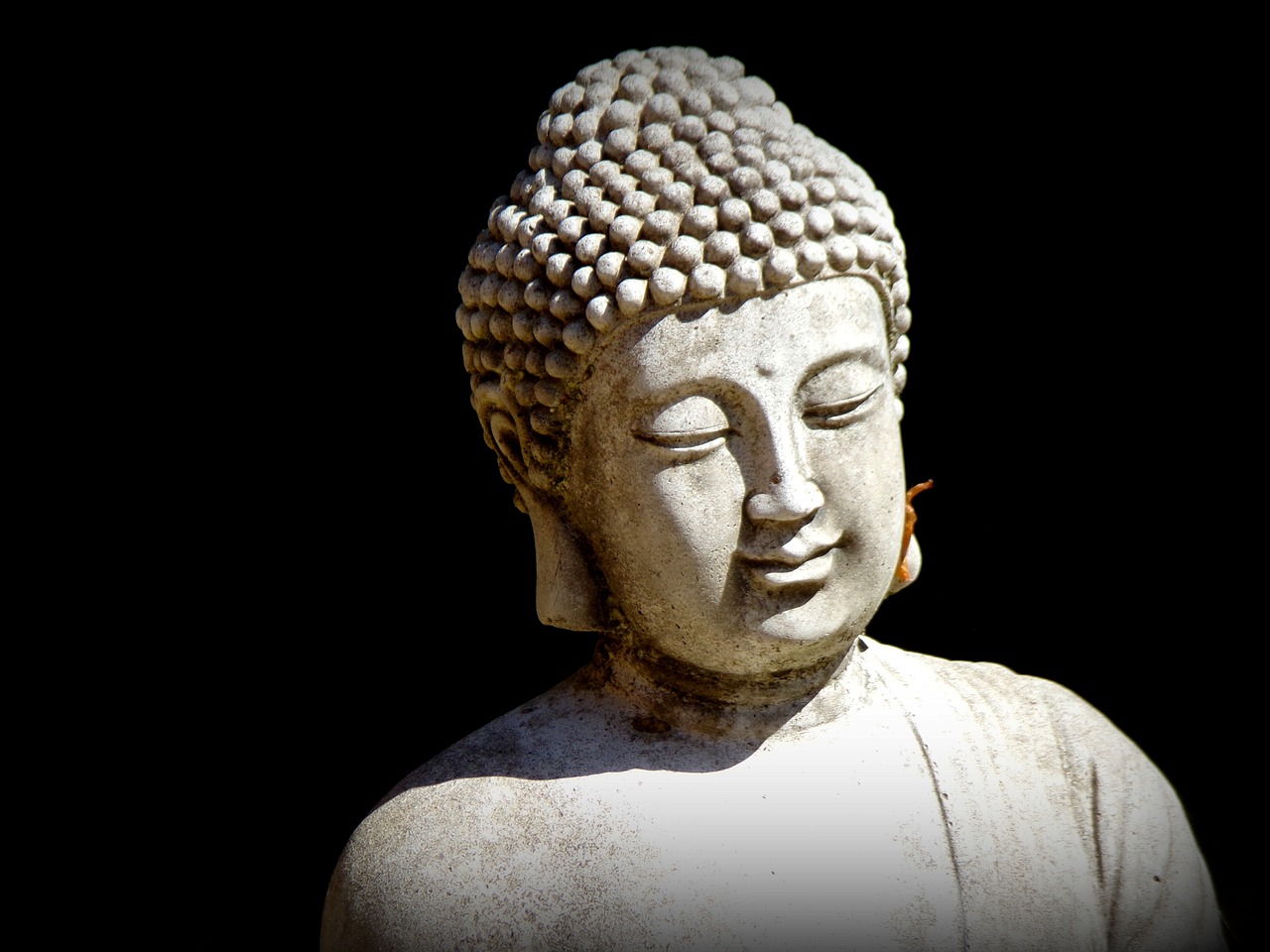
highlighting its significance in existential philosophy and its impact on contemporary thought.
Martin Heidegger's Being and Time was first published in 1927 and has since become a cornerstone of existential philosophy. This work emerged during a time of significant upheaval in Europe, with the aftermath of World War I leading to a crisis in traditional philosophical thought. Heidegger's exploration of existence and the nature of being challenged the established norms, paving the way for a new understanding of what it means to be human. Its relevance persists in modern philosophical discourse, as it continues to resonate with contemporary issues surrounding identity, existence, and the human condition.
At the heart of Being and Time are several key themes that shape Heidegger's inquiry into existence. One of the most pivotal concepts is the notion of Being itself, which Heidegger argues has been largely overlooked in Western philosophy. He introduces the term Dasein, which translates to "being-there," to emphasize the unique position of human beings in their quest for meaning. This work delves into the intricacies of human existence, exploring how our relationships with the world and others influence our understanding of being.
Dasein is more than just a term; it encapsulates the essence of human existence. Heidegger posits that our being is defined by our engagement with the world around us. This engagement is not passive; rather, it is an active participation in a network of relationships and experiences. Understanding Dasein allows us to grasp how we navigate our existence, shaping our perceptions and interactions. It reveals that we are not isolated entities but are fundamentally connected to our environment and the people within it.
One of the most compelling aspects of Heidegger's philosophy is the concept of being-in-the-world. This idea suggests that our existence is inherently linked to our surroundings. Imagine a fish in water; it cannot exist outside of its aquatic environment. Similarly, our experiences, thoughts, and identities are shaped by the contexts we inhabit. This interconnectedness influences how we perceive reality, highlighting the importance of context in our understanding of existence.
Heidegger also explores the notions of authenticity and inauthenticity, which reflect how individuals relate to their existence. Authenticity involves embracing one's true self and making conscious choices that align with one's values and beliefs. In contrast, inauthenticity arises when individuals conform to societal expectations, losing touch with their genuine selves. This tension between authenticity and inauthenticity raises questions about personal freedom and responsibility, prompting us to reflect on our choices and their implications.
Another crucial theme in Being and Time is the exploration of time and temporality. Heidegger argues that our understanding of being is deeply intertwined with our perception of time. He emphasizes that we are not merely products of our past; rather, our future possibilities shape our present existence. By recognizing the significance of historical context and future aspirations, we can better understand our place in the world and the choices we make.
Heidegger's Being and Time has had a profound impact on various philosophical movements, including existentialism, phenomenology, and postmodern thought. Its emphasis on individual experience and the subjective nature of existence has inspired thinkers to explore the complexities of human life in new ways. The work has also sparked debates on topics such as identity, meaning, and the nature of reality, making it a vital reference point in contemporary philosophical discussions.
Despite its significance, Being and Time has faced critiques and diverse interpretations. Scholars have grappled with the challenges it presents, particularly regarding its dense language and abstract concepts. Yet, these challenges have also led to rich discussions, as different lenses of interpretation continue to emerge, revealing the multifaceted nature of Heidegger's ideas.
The legacy of Martin Heidegger's philosophy is undeniable. Being and Time continues to inspire and provoke thought in modern philosophical discussions, encouraging us to question our existence and the world we inhabit. Its themes remain relevant, urging individuals to seek authenticity and engage deeply with their experiences.
- What is the main focus of Heidegger's Being and Time?
Heidegger's work primarily focuses on the nature of existence, exploring what it means to be human through the lens of Dasein and our relationships with the world.
- How does Being and Time influence modern philosophy?
The work has significantly impacted existentialism and phenomenology, shaping contemporary debates on identity, meaning, and the human condition.
- What are the key themes in Being and Time?
Key themes include Dasein, being-in-the-world, authenticity vs. inauthenticity, and the significance of time and temporality in understanding existence.

Introduction to Being and Time
Martin Heidegger's work, Being and Time, published in 1927, stands as a monumental text in the landscape of existential philosophy. It emerged during a period of profound philosophical transformation, where traditional metaphysical understandings were being challenged and reevaluated. The historical context of its publication is crucial; it was a time marked by the aftermath of World War I, a period that saw a significant shift in human thought and existential inquiry. Heidegger sought to address fundamental questions about existence, purpose, and being itself, which resonated deeply with the disillusionment of the era.
At its core, Being and Time introduces readers to the concept of Dasein, a term Heidegger uses to describe human existence. This work lays the groundwork for understanding how individuals relate to their world and the nature of their being. Heidegger's exploration of existential themes has not only shaped the trajectory of philosophy but has also influenced fields such as psychology, literature, and theology. The text challenges readers to confront their own existence and the structures that define their lives, making it a timeless piece that continues to provoke thought and discussion.
In the following sections, we will delve into the key themes of Being and Time, dissecting its intricate layers and examining how they contribute to our understanding of existence. We will also explore the book's lasting impact on contemporary philosophical thought and its relevance in modern discussions about what it means to be human.
As we embark on this journey through Heidegger's profound ideas, it's essential to recognize the significance of his work in not just philosophy, but in shaping our understanding of ourselves and our place in the universe. So, what does it mean to truly exist? How do we navigate the complexities of our being? These questions lie at the heart of Heidegger's inquiry, inviting us to explore the depths of our own experiences.

Being and Time,
This article explores the key themes and concepts of Martin Heidegger's seminal work, Being and Time, highlighting its significance in existential philosophy and its impact on contemporary thought.
Published in 1927, Martin Heidegger's Being and Time emerged during a tumultuous period in European history, marked by the aftermath of World War I and the rise of modernist thought. This groundbreaking text laid the foundation for existential philosophy, challenging traditional metaphysical views and urging readers to reconsider the nature of existence itself. Heidegger's work is not just a philosophical treatise; it is a profound exploration of what it means to be human, making it immensely relevant even in today's complex world. Its impact can be felt across various disciplines, from psychology to literature, and continues to spark debates among scholars and thinkers alike.
At the heart of Being and Time are several key themes that form the backbone of Heidegger's inquiry into existence. One of the most significant concepts is that of **Being** itself. Heidegger posits that our understanding of Being has been largely overlooked by philosophers throughout history. He introduces the term **Dasein**, which translates to "being-there," to emphasize the unique position of human beings in the world. This concept serves as a launching pad for discussing how we experience existence, our relationship with time, and the essence of our being.
Dasein is not merely an abstract idea; it is a lived experience. Heidegger argues that Dasein is characterized by its ability to question its own existence, leading to a deeper understanding of what it means to be. This self-reflective quality allows individuals to engage with their surroundings, forging connections with others and the world at large. The implications of Dasein extend beyond philosophy; they touch on psychology, ethics, and even art, as they delve into the essence of human experience.
Heidegger's notion of **being-in-the-world** is a pivotal aspect of Dasein. It suggests that our existence is not isolated; rather, it is fundamentally intertwined with our environment and the people around us. This interconnectedness shapes our perceptions and experiences, influencing how we understand reality. For instance, consider how a musician's creative process is deeply affected by their cultural context and personal relationships. In this way, being-in-the-world emphasizes that our existence is not just about individual introspection but also about our engagement with the world and others.
Another crucial theme in Heidegger's philosophy is the distinction between **authenticity** and **inauthenticity**. Authenticity refers to the idea of living in accordance with one's true self, making choices that reflect one's genuine values and beliefs. In contrast, inauthenticity often manifests as conforming to societal expectations or external pressures. This tension between authenticity and inauthenticity raises important questions about personal freedom and responsibility. How can we navigate our existence in a world that often encourages us to blend in rather than stand out? Heidegger challenges us to confront these dilemmas, urging us to embrace our individuality.
Heidegger's exploration of **time and temporality** is another cornerstone of Being and Time. He argues that our understanding of being is deeply rooted in our perception of time. Unlike the conventional view of time as a linear progression, Heidegger presents a more complex understanding, emphasizing the interplay between our past experiences, present circumstances, and future possibilities. This dynamic relationship shapes our existence, allowing us to project ourselves into the future while being informed by our history. In this sense, time is not just a measurement; it is an essential component of our being.
The profound impact of Being and Time can be seen across various philosophical movements, including **existentialism**, **phenomenology**, and **postmodern thought**. Heidegger's ideas have influenced a wide range of thinkers, from Jean-Paul Sartre to Michel Foucault, and continue to resonate in contemporary philosophical debates. His work challenges us to rethink our understanding of existence, urging us to confront the complexities of being in a rapidly changing world.
Despite its acclaim, Being and Time has faced its share of critiques. Scholars have raised questions about the accessibility of Heidegger's writing style and the implications of his thoughts on technology and modernity. Various interpretations have emerged, each shedding light on different aspects of his philosophy. Some argue that Heidegger's focus on individual existence overlooks the importance of social structures, while others highlight the ethical implications of his ideas.
Reflecting on the legacy of Martin Heidegger's philosophy, it is clear that Being and Time continues to inspire and provoke thought in modern philosophical discussions and beyond. Its exploration of existence, time, and authenticity resonates with individuals grappling with the complexities of contemporary life. As we navigate our own paths, Heidegger's insights encourage us to embrace our individuality and confront the fundamental questions of our existence.
- What is the main idea of Being and Time?
The main idea revolves around the exploration of existence, particularly through the concept of Dasein, which emphasizes our unique position as beings who question their own existence.
- How does Heidegger define Dasein?
Dasein, or "being-there," refers to the experience of being human, characterized by self-awareness and the capacity to engage with the world and others.
- Why is Being and Time significant in philosophy?
It challenges traditional metaphysical views, offering a new perspective on existence that has influenced numerous philosophical movements and continues to be relevant today.

discussing its publication, historical context, and foundational role in existential philosophy, as well as its enduring relevance in modern philosophical discourse.
Being and Time, published in 1927, is one of the most influential works in the realm of philosophy, particularly within the field of existentialism. Martin Heidegger, a German philosopher, sought to address the fundamental question of what it means to be. At a time when the world was grappling with the aftermath of World War I, Heidegger’s work emerged as a profound inquiry into human existence, challenging the traditional metaphysical perspectives that had dominated Western philosophy for centuries. This seminal text not only laid the groundwork for existential philosophy but also sparked a vibrant discourse that continues to resonate in modern philosophical circles.
The historical context of Being and Time is crucial to understanding its significance. Published during a period of existential crisis and societal upheaval, Heidegger's work reflects a deep concern for the human condition. The early 20th century was marked by rapid industrialization, the disillusionment of the war, and a growing sense of alienation. In this landscape, Heidegger's exploration of existence became a beacon for those seeking meaning in a seemingly chaotic world. His focus on the individual experience and the concept of Dasein—or "being-there"—invited readers to engage in a personal and introspective journey, thus establishing a foundational role in existential philosophy.
Heidegger's impact on existentialism is profound. His ideas influenced a myriad of philosophers, including Jean-Paul Sartre and Simone de Beauvoir, who further developed the themes of freedom, choice, and authenticity. By emphasizing the importance of individual existence and the subjective experience of being, Heidegger paved the way for a philosophical movement that prioritized personal meaning over abstract reasoning. The enduring relevance of Being and Time can be seen in contemporary discussions surrounding identity, consciousness, and the nature of reality. Philosophers today continue to grapple with Heidegger's insights, demonstrating that his work is not merely a relic of the past but a living dialogue that shapes our understanding of existence.
Exploring the central themes of Being and Time, including the concept of Being, Dasein, and the nature of existence, which form the backbone of Heidegger's philosophical inquiry.
A deep dive into Dasein, or being-there, which is central to Heidegger's analysis of human existence, revealing how it shapes our understanding of being and our relationship with the world.
An examination of Heidegger's notion of being-in-the-world, highlighting how our existence is fundamentally intertwined with our environment and others, influencing our experiences and understanding of reality.
Discussing the concepts of authenticity and inauthenticity in Heidegger's philosophy, illustrating how individuals navigate their existence and the implications for personal freedom and responsibility.
Analyzing Heidegger's exploration of time and temporality, emphasizing the significance of historical context and future possibilities in shaping human existence and understanding of being.
A look at the profound impact of Being and Time on various philosophical movements, including existentialism, phenomenology, and postmodern thought, and its relevance in contemporary philosophical debates.
Evaluating the critiques and diverse interpretations of Heidegger's work, addressing both the philosophical challenges it presents and the various lenses through which scholars have approached his ideas.
Reflecting on the legacy of Martin Heidegger's philosophy, considering how Being and Time continues to inspire and provoke thought in modern philosophical discussions and beyond.
- What is Dasein in Heidegger's philosophy? Dasein refers to the experience of being that is unique to humans, emphasizing our existence in the world.
- How does Being and Time influence modern philosophy? It laid the groundwork for existentialism and continues to impact discussions on identity and existence.
- What are the main themes of Being and Time? The key themes include the nature of Being, authenticity, temporality, and the concept of being-in-the-world.

Key Themes in Being and Time
In Martin Heidegger's Being and Time, the exploration of key themes forms the very essence of his philosophical inquiry. At the heart of this work lies the profound concept of Being, which Heidegger argues has been largely overlooked by Western philosophy. Instead of merely defining existence, he urges us to ask, "What does it mean to be?" This question is not just an abstract philosophical exercise; it touches the core of our everyday lives and experiences.
One of the central themes that emerge is the notion of Dasein, which translates to "being-there." Dasein represents human existence in its most authentic form. It encapsulates the idea that we are not isolated entities but are fundamentally connected to the world around us. Heidegger suggests that to understand ourselves, we must first understand our being-in-the-world. This concept emphasizes that our existence is intertwined with our environment and the people we interact with. In essence, we are shaped by our surroundings just as much as we shape them.
Another significant theme is the distinction between authenticity and inauthenticity. Heidegger posits that many individuals live in a state of inauthenticity, conforming to societal norms and expectations without truly engaging with their own existence. This raises the question: how do we reclaim our authenticity? By confronting our own mortality and the inevitability of death, we can begin to live more genuinely. Embracing our freedom and responsibility allows us to make choices that reflect our true selves rather than merely following the crowd.
Heidegger also delves into the concept of time and temporality, which are crucial for understanding human existence. He argues that our perception of time is not linear but rather a complex interplay between the past, present, and future. Our historical context shapes our current experiences, while our aspirations for the future influence our decisions today. This temporal aspect of existence is vital; it reminds us that our being is always in flux, constantly evolving as we navigate through life.
To illustrate these themes, consider the following table that summarizes the key concepts discussed:
| Theme | Description |
|---|---|
| Being | The fundamental question of existence, prompting us to explore what it means to be. |
| Dasein | Human existence as 'being-there,' emphasizing our connection to the world. |
| Authenticity | The pursuit of genuine existence, free from societal constraints. |
| Time | The interplay of past, present, and future that shapes our experiences. |
In conclusion, the key themes in Being and Time invite us to reflect deeply on our existence. They challenge us to confront the nature of our being, the authenticity of our lives, and the temporal dimensions that influence our choices. Heidegger's work is not merely theoretical; it urges us to engage with our existence actively and meaningfully.
- What is the main focus of Heidegger's Being and Time?
Heidegger's Being and Time primarily focuses on the nature of existence and the concept of being, particularly through the lens of human experience (Dasein). - How does Dasein relate to authenticity?
Dasein, or "being-there," is central to understanding authenticity. Heidegger suggests that individuals can live authentically by confronting their existence and making choices that reflect their true selves. - Why is temporality important in Heidegger's philosophy?
Temporality is crucial because it shapes our understanding of existence. Our past experiences and future possibilities influence how we perceive and engage with the present.

Being and Time,
This article explores the key themes and concepts of Martin Heidegger's seminal work, Being and Time, highlighting its significance in existential philosophy and its impact on contemporary thought.
Published in 1927, Martin Heidegger's Being and Time represents a pivotal moment in the landscape of philosophy. It emerged during a time of great upheaval in Europe, following World War I, and sought to address the fundamental questions surrounding existence and being. Heidegger's work laid the groundwork for existential philosophy, challenging readers to reconsider their understanding of what it means to be. This text has not only shaped philosophical discourse but continues to resonate in modern discussions about existence, identity, and the human condition.
At the heart of Being and Time are several central themes that Heidegger meticulously unpacks. These include the concept of Being itself, Dasein, and the intricate nature of existence. Heidegger's inquiry into these themes forms a backbone that supports his entire philosophical framework. He invites us to explore not just the abstract notion of existence but to delve into the lived experience of being. This exploration is not merely academic; it has profound implications for how we perceive our place in the world.
One of the most intriguing aspects of Heidegger's philosophy is the concept of Dasein, which translates to "being-there." Dasein is not just a term; it represents a way of understanding human existence. Heidegger argues that to be human is to be thrown into a world filled with meaning and relationships. This notion of being-there emphasizes our active engagement with the world around us. It’s like being a dancer in a grand ballet where every movement influences the performance. Our existence is not isolated; it is deeply intertwined with the environment and the people we encounter.
Heidegger's notion of being-in-the-world is a crucial component of Dasein. He posits that our existence is fundamentally linked to our surroundings and the interactions we have with others. Imagine a fish swimming in water; it cannot exist separately from its environment. Similarly, humans cannot detach themselves from the world we inhabit. This interconnectedness shapes our experiences and influences our understanding of reality. Our perceptions are colored by the context in which we find ourselves, making it essential to acknowledge the world as a dynamic space of relationships.
In exploring the concepts of authenticity and inauthenticity, Heidegger challenges us to reflect on how we navigate our existence. Authenticity is about embracing our individuality and making choices that resonate with our true selves. In contrast, inauthenticity arises when we conform to societal expectations or live in a way that is disconnected from our essence. Think of it as wearing a mask; while it may protect us from vulnerability, it also obscures our true identity. Heidegger implores us to shed these masks and confront the freedom and responsibility that come with authenticity.
Heidegger's exploration of time and temporality is another significant theme in Being and Time. He emphasizes that our understanding of being is inextricably linked to our experience of time. Rather than viewing time as a linear progression, Heidegger suggests that it is a complex interplay of past, present, and future. Our historical context shapes who we are, while our possibilities for the future influence our current choices. This dynamic relationship compels us to recognize that we are not merely products of our environment but active participants in the unfolding of our existence.
The impact of Being and Time on various philosophical movements is profound. It has significantly influenced existentialism, phenomenology, and even postmodern thought. Philosophers like Jean-Paul Sartre and Maurice Merleau-Ponty drew heavily from Heidegger's ideas, exploring the nuances of human existence and perception. The relevance of Being and Time in contemporary philosophical debates cannot be overstated, as it continues to provoke discussions about existence, identity, and the nature of reality.
While Heidegger's work has garnered immense respect, it has also faced critiques. Scholars have debated the implications of his ideas, particularly concerning his political affiliations and the complexities of his language. Various interpretations of Being and Time have emerged, each offering unique insights into Heidegger's thought. Engaging with these critiques enriches our understanding and invites us to grapple with the philosophical challenges he presents.
The legacy of Martin Heidegger's philosophy is enduring. Being and Time continues to inspire and provoke thought in modern philosophical discussions and beyond. Its exploration of existence resonates with individuals seeking meaning in a rapidly changing world. As we navigate the complexities of our lives, Heidegger's insights remind us to remain attuned to our authentic selves and the interconnectedness of our existence.
- What is the main focus of Heidegger's Being and Time? The main focus is to explore the nature of being and existence, particularly through the concept of Dasein.
- How does Heidegger define Dasein? Dasein, or "being-there," refers to the unique way humans exist in the world, characterized by awareness and engagement with their surroundings.
- What is the significance of authenticity in Heidegger's philosophy? Authenticity is crucial as it represents living in accordance with one's true self, free from societal expectations and norms.
- How has Being and Time influenced modern philosophy? It has laid the groundwork for existentialism and phenomenology, shaping discussions around identity, existence, and human experience.

including the concept of Being, Dasein, and the nature of existence, which form the backbone of Heidegger's philosophical inquiry.
In Martin Heidegger's Being and Time, the exploration of the concept of Being, the notion of Dasein, and the intricate nature of existence serve as the backbone of his philosophical inquiry. Heidegger challenges us to reconsider our understanding of what it means to "be." Unlike traditional metaphysics, which often treats Being as a static entity, Heidegger emphasizes its dynamic and relational qualities. This shift invites readers to engage with the world in a more profound way, prompting essential questions about our own existence.
At the heart of Heidegger's philosophy is the concept of Dasein, which translates to "being-there." This term encapsulates the unique way humans experience their existence. Dasein is not just a label for human beings; it signifies a mode of being that is conscious, self-aware, and fundamentally engaged with the world around it. Heidegger argues that our existence is characterized by our relationships with others and our environment, making Dasein a deeply social and contextual phenomenon.
Heidegger further elaborates on Dasein by introducing the idea of being-in-the-world. This concept underscores that we are not isolated entities but rather embedded within a network of relationships and meanings. Our experiences are shaped by our surroundings, and in turn, we shape our environments through our actions and interpretations. This interconnectedness is crucial for understanding how we relate to both ourselves and the world, emphasizing that existence is not merely a solitary endeavor.
| Component | Description |
|---|---|
| Being-in-the-World | The idea that our existence is always situated within a specific context, influenced by our relationships and environment. |
| Authenticity | The pursuit of a genuine existence, where individuals take responsibility for their choices and live according to their true self. |
| Inauthenticity | A state where individuals conform to societal norms and expectations, losing touch with their authentic selves. |
Moreover, Heidegger's exploration of existence leads to a discussion about authenticity and inauthenticity. He posits that many individuals live in a state of inauthenticity, where they allow societal pressures and expectations to dictate their lives. In contrast, authenticity involves recognizing one's own potential and making choices that align with one's true self. This journey toward authenticity is not just a personal endeavor; it is a profound existential challenge that invites individuals to reflect on their values, beliefs, and the very essence of their being.
As we delve deeper into the nature of existence, we encounter Heidegger's perspective on time and temporality. He argues that our understanding of being is inherently linked to our temporal experience. Unlike the conventional notion of time as a linear progression, Heidegger suggests that time is more fluid, characterized by our past, present, and future possibilities. This understanding of temporality plays a crucial role in shaping our identity and our engagement with the world. By recognizing the significance of our historical context and the potential for future actions, we can better grasp the complexities of existence.
- What is the main focus of Heidegger's Being and Time?
The main focus is to explore the nature of Being and human existence, particularly through the concept of Dasein. - How does Dasein relate to authenticity?
Dasein represents our unique mode of being, and authenticity is achieved when we make choices that reflect our true selves rather than conforming to societal expectations. - Why is the concept of time important in Being and Time?
Heidegger emphasizes that our understanding of existence is deeply intertwined with our experience of time, shaping our identity and actions.

The Concept of Dasein
The term Dasein, a German word that translates to "being-there," is at the heart of Martin Heidegger's philosophical inquiry in Being and Time. Dasein is not merely a concept; it embodies the essence of human existence, emphasizing our unique capacity to reflect on our own being. Heidegger introduces Dasein as a way to explore the intricacies of existence, pushing us to confront the fundamental question: what does it mean to be?
One of the remarkable aspects of Dasein is its relational nature. Heidegger argues that we are not isolated entities; rather, we exist in a web of relationships with the world around us. This interconnectedness shapes our experiences and influences our understanding of reality. When we think about Dasein, we must consider how our surroundings, our relationships, and our historical context all contribute to shaping our being. Dasein is inherently social, suggesting that our existence is defined by our interactions with others, as well as our engagement with the world.
Moreover, Dasein is characterized by its temporality. Heidegger emphasizes that our understanding of being is not static; it evolves as we navigate through time. We are constantly influenced by our past experiences, which inform our present actions and future possibilities. This temporal dimension of Dasein leads to the realization that we are always in a state of becoming, constantly shaping our identity through choices and experiences. In this sense, Dasein is not just about existing; it is about the journey of existence itself.
To better understand the concept of Dasein, we can break it down into several key aspects:
- Being-in-the-world: This idea highlights how Dasein is always situated in a specific context, interacting with its environment.
- Care: Heidegger describes Dasein as fundamentally concerned with its own existence and the existence of others, which leads to a sense of care and responsibility.
- Authenticity: Dasein has the potential to live authentically, making conscious choices that reflect its true self, rather than conforming to societal expectations.
Understanding Dasein is crucial for grasping the broader themes of Being and Time. It serves as a lens through which we can examine our existence, our relationships, and our place in the world. By engaging with the concept of Dasein, we are invited to reflect on our own lives and consider how we relate to the existential questions that define our humanity.

being-there,
This article explores the key themes and concepts of Martin Heidegger's seminal work, Being and Time, highlighting its significance in existential philosophy and its impact on contemporary thought.
An overview of Martin Heidegger's Being and Time, discussing its publication, historical context, and foundational role in existential philosophy, as well as its enduring relevance in modern philosophical discourse.
Exploring the central themes of Being and Time, including the concept of Being, Dasein, and the nature of existence, which form the backbone of Heidegger's philosophical inquiry.
A deep dive into Dasein, or being-there, which is central to Heidegger's analysis of human existence, revealing how it shapes our understanding of being and our relationship with the world.
An examination of Heidegger's notion of being-in-the-world, highlighting how our existence is fundamentally intertwined with our environment and others, influencing our experiences and understanding of reality.
Discussing the concepts of authenticity and inauthenticity in Heidegger's philosophy, illustrating how individuals navigate their existence and the implications for personal freedom and responsibility.
Analyzing Heidegger's exploration of time and temporality, emphasizing the significance of historical context and future possibilities in shaping human existence and understanding of being.
A look at the profound impact of Being and Time on various philosophical movements, including existentialism, phenomenology, and postmodern thought, and its relevance in contemporary philosophical debates.
Evaluating the critiques and diverse interpretations of Heidegger's work, addressing both the philosophical challenges it presents and the various lenses through which scholars have approached his ideas.
Reflecting on the legacy of Martin Heidegger's philosophy, considering how Being and Time continues to inspire and provoke thought in modern philosophical discussions and beyond.
The concept of being-there, or Dasein, is not merely a philosophical abstraction; it's a profound exploration of what it means to exist as a human being. Heidegger invites us to consider our everyday experiences and interactions, emphasizing that our being is always situated in a specific context. This means that our understanding of ourselves and the world is shaped by the relationships we cultivate and the environments we inhabit. Imagine walking through a bustling city; each encounter, each sound, and each sight contributes to your sense of self and reality. In this way, Dasein is a continuous interplay between the self and the surrounding world.
Heidegger argues that to truly grasp the essence of Dasein, one must acknowledge the significance of our being-in-the-world. This notion suggests that we are not isolated beings; rather, we are fundamentally connected to others and the world around us. Our existence is a tapestry woven from our interactions, experiences, and the meanings we attach to them. For instance, think of how your mood can shift based on the company you keep or the environment you find yourself in. This interdependence highlights the relational aspect of our existence, making it clear that to be human is to be involved in a web of connections.
Moreover, Heidegger emphasizes the importance of authenticity in our being-there. Authenticity refers to the idea of living in accordance with one's true self, rather than conforming to societal expectations or the pressures of the crowd. When we embrace our authentic selves, we acknowledge our unique experiences and perspectives, allowing us to navigate our existence with purpose and intention. In contrast, inauthenticity arises when we lose sight of our individuality, becoming mere reflections of others' expectations. This struggle between authenticity and inauthenticity is a central theme in our quest for meaning in life.
In summary, the concept of being-there serves as a foundation for understanding our existence. It challenges us to reflect on our relationships, our environment, and our authenticity. By engaging with these ideas, we can cultivate a deeper awareness of ourselves and our place in the world, ultimately leading to a more fulfilling and meaningful existence.
- What is Dasein in Heidegger's philosophy?
Dasein refers to the experience of being that is unique to humans, emphasizing our existence as being-in-the-world. - How does being-there influence our understanding of existence?
Being-there connects our individual existence with the world and others, shaping our experiences and meanings. - What is the significance of authenticity in being-there?
Authenticity involves living in accordance with one's true self, which is essential for a meaningful existence.

which is central to Heidegger's analysis of human existence, revealing how it shapes our understanding of being and our relationship with the world.
This article explores the key themes and concepts of Martin Heidegger's seminal work, Being and Time, highlighting its significance in existential philosophy and its impact on contemporary thought.
An overview of Martin Heidegger's Being and Time, discussing its publication, historical context, and foundational role in existential philosophy, as well as its enduring relevance in modern philosophical discourse.
Exploring the central themes of Being and Time, including the concept of Being, Dasein, and the nature of existence, which form the backbone of Heidegger's philosophical inquiry.
A deep dive into Dasein, or being-there, which is central to Heidegger's analysis of human existence, revealing how it shapes our understanding of being and our relationship with the world.
Heidegger introduces the notion of being-in-the-world to illustrate that our existence is not separate from the world around us; instead, it is intricately connected to our environment and the people we interact with. This concept emphasizes that we are not isolated beings, but rather, we exist in a web of relationships and contexts that influence our perception of reality. Imagine a fish swimming in the ocean; it cannot separate itself from the water it inhabits. Similarly, our experiences and understanding are shaped by the world we live in.
Discussing the concepts of authenticity and inauthenticity in Heidegger's philosophy, illustrating how individuals navigate their existence and the implications for personal freedom and responsibility.
Analyzing Heidegger's exploration of time and temporality, emphasizing the significance of historical context and future possibilities in shaping human existence and understanding of being.
A look at the profound impact of Being and Time on various philosophical movements, including existentialism, phenomenology, and postmodern thought, and its relevance in contemporary philosophical debates.
Evaluating the critiques and diverse interpretations of Heidegger's work, addressing both the philosophical challenges it presents and the various lenses through which scholars have approached his ideas.
Reflecting on the legacy of Martin Heidegger's philosophy, considering how Being and Time continues to inspire and provoke thought in modern philosophical discussions and beyond.
- What is the main idea of Heidegger's Dasein?
Dasein refers to the experience of being that is unique to human beings, emphasizing our existence in the world and our capacity for self-reflection.
- How does Heidegger define authenticity?
Authenticity, for Heidegger, involves recognizing and embracing one's own existence and choices, rather than conforming to societal expectations.
- Why is Being and Time considered a foundational text in existential philosophy?
It lays the groundwork for understanding human existence and explores profound questions about meaning, time, and our relationship with the world.

Being-in-the-World
When we dive into Martin Heidegger's concept of , we're not just scratching the surface of his philosophy; we're embarking on a journey that fundamentally reshapes our understanding of existence. Imagine standing in a bustling city, surrounded by towering buildings, the chatter of people, and the hum of traffic. This vivid scene isn’t just a backdrop; it’s an integral part of who you are. Heidegger argues that our existence is intricately woven into the fabric of our environment and the relationships we cultivate within it.
At the heart of is the idea that we are not isolated beings, but rather, our identities and experiences are shaped by the world around us. This concept challenges the traditional notion of a detached observer. Instead, we are participants in a dynamic interplay between our surroundings and ourselves. Heidegger emphasizes that to truly understand our Dasein—our being-there—we must recognize that we are always situated within a specific context that influences our perceptions and actions.
Heidegger breaks this down into several key aspects:
- Interconnectedness: Our existence is not just about individual experiences; it’s about how we relate to others and our environment. Think of it like a spider web—each thread represents a relationship or experience that contributes to the overall structure of our being.
- Engagement: Being-in-the-world is an active process. It's about how we engage with our surroundings, making choices that reflect our understanding of ourselves and our place in the world.
- Contextual Understanding: Our understanding of reality is deeply influenced by our historical and cultural contexts. Just as a painter uses different colors to create a masterpiece, our experiences color our perception of existence.
Moreover, Heidegger posits that this being-in-the-world is not a static condition; it evolves as we navigate through life. Our interactions with others, the choices we make, and the environments we inhabit continuously shape our understanding of who we are. It’s like a dance—each step we take influences the rhythm and flow of our existence.
In essence, being-in-the-world is a call to recognize the profound connection we share with our surroundings. It urges us to step out of our isolated bubbles and engage with the world around us, embracing the complexities that come with it. This perspective not only enriches our understanding of existence but also invites us to take responsibility for how we navigate our relationships and environments.
As we reflect on Heidegger's insights, we might ask ourselves: How does our environment shape our identity? What responsibilities do we hold in our interactions with others? By pondering these questions, we delve deeper into the essence of being-in-the-world, uncovering layers of meaning that resonate with our everyday experiences.

Authenticity and Inauthenticity
In the labyrinth of Martin Heidegger's philosophy, the concepts of authenticity and inauthenticity serve as pivotal points that guide us through the intricate nature of human existence. To grasp these ideas, we need to understand that authenticity is not merely a buzzword or a modern-day trend; it is a profound state of being that reflects our true selves, stripped of the societal masks we often wear. Heidegger posits that individuals frequently fall into the trap of inauthenticity, where they conform to the expectations and norms imposed by the world around them. This state of being is akin to living in a shadow, where one's existence is dictated by external influences rather than by personal choices.
Heidegger describes authenticity as the realization of one’s unique potential and the acceptance of one’s own mortality. It's the moment when we confront the reality of our existence and make conscious choices that align with our true selves. This journey towards authenticity requires a radical shift in perspective, one that embraces the idea that we are not just passive observers of life, but active participants who shape our destiny. In contrast, inauthenticity represents a form of escape—a way of avoiding the weight of responsibility that comes with freedom. It is the comfort of blending into the crowd, where we can hide behind the collective identity and avoid the existential angst that accompanies self-awareness.
The implications of these concepts stretch far beyond mere philosophical discourse. They resonate with our daily lives, prompting us to ask ourselves: Are we living authentically? Are we making choices that reflect who we truly are? Or are we simply going through the motions, allowing societal pressures to dictate our paths? To explore these questions, Heidegger encourages us to engage in a process of self-reflection, to peel back the layers of our existence, and to confront the uncomfortable truths that lie beneath the surface.
In practical terms, pursuing authenticity involves several key steps:
- Self-Reflection: Take time to examine your beliefs, values, and motivations. What drives you? What do you truly care about?
- Embrace Vulnerability: Allow yourself to be open and honest about your feelings and experiences. Authenticity thrives in vulnerability.
- Make Conscious Choices: Instead of defaulting to societal expectations, make choices that resonate with your true self, even if they are unconventional.
- Accept Responsibility: Acknowledge that with freedom comes responsibility. Own your choices and their consequences.
Ultimately, the dance between authenticity and inauthenticity is a dynamic one. It is not a binary choice but rather a spectrum that we navigate throughout our lives. As we strive for authenticity, we may find ourselves slipping into inauthenticity at times, but the key is to recognize these moments and return to our true selves. By doing so, we not only enrich our own lives but also contribute to a more genuine and meaningful existence for those around us.
- What is the difference between authenticity and inauthenticity?
Authenticity refers to living in accordance with one's true self, while inauthenticity involves conforming to external expectations and norms. - How can I cultivate authenticity in my life?
Engage in self-reflection, embrace vulnerability, make conscious choices, and accept responsibility for your actions. - Why is authenticity important?
Authenticity fosters a deeper connection with oneself and others, leading to a more fulfilling and meaningful life experience.
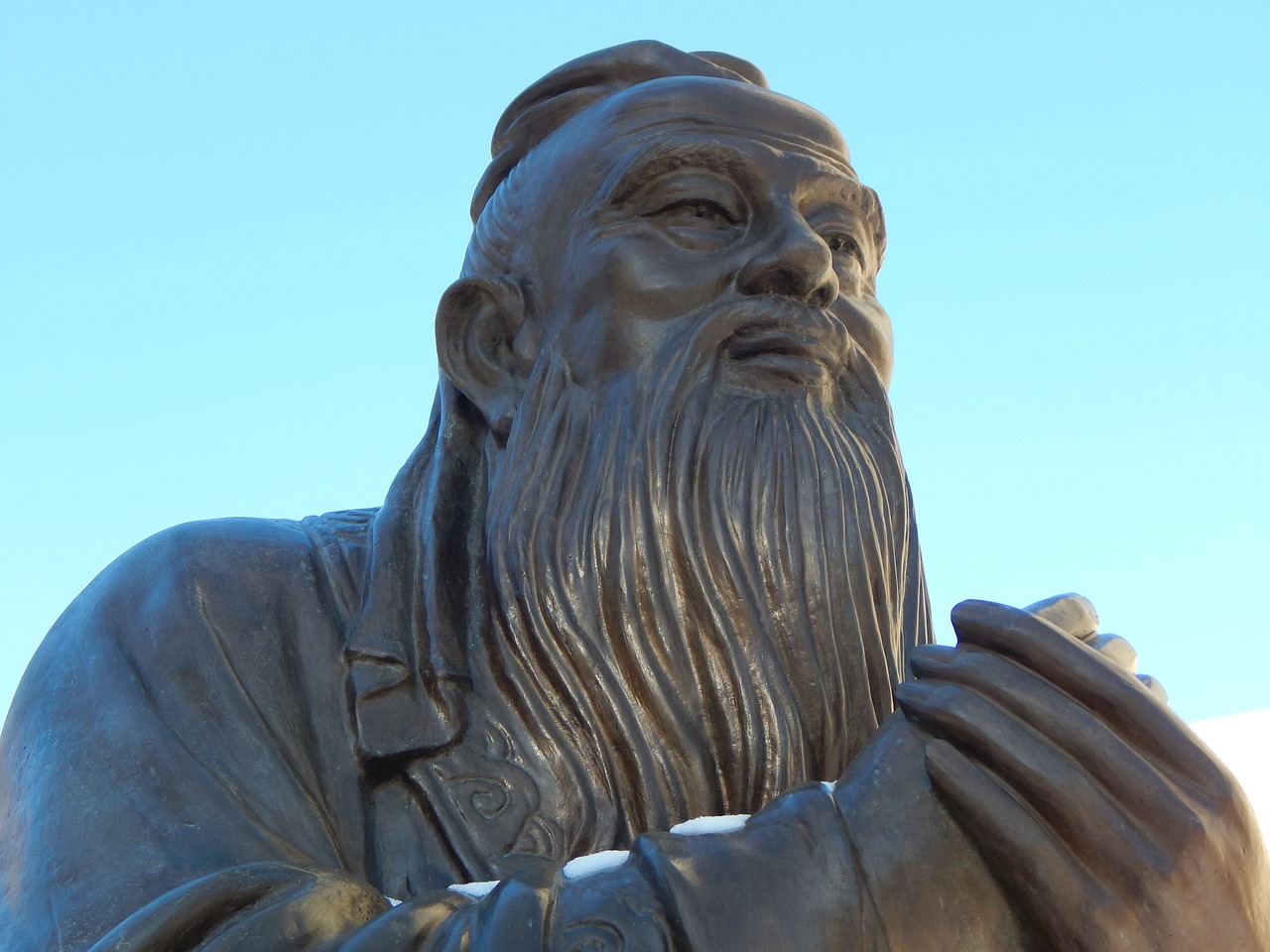
Time and Temporality
In Being and Time, Martin Heidegger delves deeply into the intricate relationship between time and our understanding of existence. He argues that time is not merely a linear sequence of past, present, and future but a fundamental aspect of our being. This perspective shifts the way we think about existence, suggesting that our experiences are deeply intertwined with our temporal context. Heidegger introduces the idea of temporality as a core element in grasping the essence of being, positing that our understanding of ourselves and our world is shaped by our temporal experiences.
Heidegger’s exploration of time can be summarized in a few key points:
- Historical Context: Our past experiences inform our present decisions and future possibilities. This interconnectedness highlights how we are shaped by the histories we carry within us.
- Future Possibilities: The concept of projection is vital; we are always looking forward, envisioning potential futures that influence our current actions.
- Present Engagement: Heidegger emphasizes the importance of being fully present in the moment, as it is where our existence truly unfolds.
Heidegger's analysis of time leads to the understanding that our existence is not static but rather a dynamic interplay of past recollections, present engagements, and future aspirations. This fluidity of time suggests that we are always in a state of becoming, constantly shaped by our temporal experiences. He introduces the term Dasein to describe this being that is aware of its own existence in time. Dasein is not just a passive observer of time; it actively participates in its flow, making choices that resonate through its temporal experience.
Moreover, Heidegger challenges the conventional notion of time as a measurable entity, proposing that it is more about the qualitative experiences we have rather than quantitative measurements. In his view, time is a horizon that encompasses our existence, shaping our understanding of being. This perspective invites us to reflect on how our lives are not merely a series of moments but a rich tapestry woven through our experiences across time.
In conclusion, Heidegger's insights into time and temporality compel us to reconsider our relationship with existence. He invites us to embrace the complexity of our temporal nature and recognize that our understanding of being is fundamentally rooted in how we navigate the past, present, and future. This profound shift in perspective has lasting implications not only for philosophy but for how we live our daily lives, encouraging us to engage more fully with the moments that define our existence.
Q: What is the main argument of Heidegger regarding time?
A: Heidegger argues that time is not just a sequence of moments but a fundamental aspect of our being, shaping our existence through past experiences, present engagements, and future possibilities.
Q: How does Heidegger define Dasein?
A: Dasein, or "being-there," refers to the unique way humans experience existence, characterized by awareness of one's own being and the temporal nature of life.
Q: Why is the concept of temporality important in existential philosophy?
A: Temporality is crucial because it emphasizes the dynamic nature of existence, suggesting that our understanding of being is continually shaped by our experiences across time.

The Influence of Being and Time
Martin Heidegger's Being and Time has cast a long shadow over the landscape of philosophy since its publication in 1927. This work is not just a book; it's a seismic shift in how we understand existence, and its influence can be felt across various philosophical movements. From existentialism to phenomenology and even postmodern thought, Heidegger's ideas have sparked countless discussions and debates. Have you ever wondered how a single work can ripple through time, affecting thinkers and scholars in ways that are both profound and unexpected? That's the magic of Being and Time.
One of the most significant impacts of Heidegger's work is its foundational role in existential philosophy. By placing emphasis on individual experience and the concept of Dasein, or "being-there," Heidegger challenged traditional metaphysical views. He urged us to confront our existence, our choices, and our relationships with the world around us. This shift paved the way for later existentialists, such as Jean-Paul Sartre and Simone de Beauvoir, who further explored the implications of human freedom and responsibility. In this sense, Being and Time serves as a philosophical springboard, launching ideas that would shape 20th-century thought.
Moreover, Heidegger's exploration of being-in-the-world has resonated deeply within phenomenology. Thinkers like Maurice Merleau-Ponty built upon Heidegger's insights, emphasizing the embodied nature of human experience. The idea that our existence is fundamentally intertwined with our environment and others has led to rich discussions about perception, consciousness, and the nature of reality. In fact, it’s fascinating to consider how Heidegger’s thoughts on temporality and existence have influenced contemporary debates in cognitive science and psychology.
In addition to existentialism and phenomenology, Being and Time has also left its mark on postmodern thought. Philosophers like Jacques Derrida and Michel Foucault have engaged with Heideggerian concepts, often critiquing or reinterpreting them to fit their frameworks. The fluidity of meaning, the questioning of absolute truths, and the focus on language as a medium of existence can all trace their roots back to Heidegger's original inquiries. This intertextual dialogue illustrates how Being and Time continues to inspire and provoke thought, challenging us to reconsider our assumptions about existence.
To better understand the influence of Being and Time, we can look at a brief overview of its impact on various philosophical movements:
| Philosophical Movement | Key Influences |
|---|---|
| Existentialism | Sartre, de Beauvoir; focus on individual freedom and responsibility |
| Phenomenology | Merleau-Ponty; emphasis on embodied experience |
| Postmodernism | Derrida, Foucault; critique of absolute truths and fluidity of meaning |
In conclusion, the influence of Being and Time is not confined to the pages of a book; it has sparked a revolution in philosophical thought that continues to resonate today. By challenging us to confront our existence and our relationships with the world, Heidegger has opened up avenues for exploration that scholars are still navigating. The questions he raised about authenticity, temporality, and being remain central to contemporary discussions, proving that his work is as relevant now as it was nearly a century ago.
- What is the main theme of Being and Time?
The main theme revolves around the concept of Being, particularly focusing on human existence as Dasein, or "being-there," and how it relates to time and authenticity. - How has Being and Time influenced modern philosophy?
It has profoundly impacted existentialism, phenomenology, and postmodern thought, shaping discussions around individual freedom, consciousness, and the nature of reality. - Who are some philosophers influenced by Heidegger?
Notable philosophers include Jean-Paul Sartre, Simone de Beauvoir, Maurice Merleau-Ponty, Jacques Derrida, and Michel Foucault.

Being and Time
Published in 1927, Martin Heidegger's is a cornerstone of existential philosophy that continues to resonate in modern philosophical discourse. Set against the backdrop of a world recovering from the devastation of World War I, Heidegger's work emerged as a profound inquiry into the nature of existence itself. The book is not just a philosophical treatise; it's a call to explore the very essence of what it means to be. Its foundational role in existentialism has inspired countless thinkers, making it an enduring subject of study and debate.
At the heart of lies a rich tapestry of themes that challenge our understanding of existence. The central concept of Being serves as a lens through which we can explore the intricacies of human life. Heidegger introduces us to Dasein, a German term that translates to "being-there," which encapsulates the essence of human existence. Through Dasein, Heidegger posits that our existence is not merely a state of being but an active engagement with the world around us.
Dasein is not just a philosophical term; it’s a profound exploration of what it means to exist as a human being. Heidegger emphasizes that Dasein is always situated within a specific context, shaped by its experiences, relationships, and environment. This concept invites us to consider how our understanding of ourselves is influenced by our surroundings and interactions with others. Think of Dasein as a dance between the self and the world, where each step is informed by the rhythm of our experiences.
Heidegger's notion of being-in-the-world illustrates that our existence cannot be separated from the world we inhabit. We are not isolated beings; rather, we are deeply intertwined with our environment and the people around us. This interconnectedness means that our experiences, emotions, and even our understanding of reality are shaped by our interactions with the world. Imagine a tree: its roots delve deep into the earth, drawing nourishment from the soil, while its branches reach for the sky, interacting with the air and sunlight. In the same way, our existence is rooted in our relationships and experiences.
In , Heidegger introduces the concepts of authenticity and inauthenticity. Authenticity refers to living a life that is true to oneself, embracing one's individuality and responsibilities. In contrast, inauthenticity represents a life lived in accordance with societal expectations and norms, often leading to a sense of disconnection from one's true self. This dichotomy raises critical questions about personal freedom: Are we truly free if we conform to external pressures? The journey toward authenticity is both a challenge and a liberation, urging us to reflect on our choices and the paths we take.
Heidegger's exploration of time and temporality is another crucial aspect of his philosophy. He argues that our understanding of being is intrinsically linked to our experience of time. Unlike conventional views that treat time as a linear progression, Heidegger sees it as a complex interplay of past, present, and future. Our historical context shapes our identity, while our anticipations of the future influence our current actions. By understanding our temporality, we can better navigate our existence and make meaningful choices that resonate with our authentic selves.
The impact of on various philosophical movements is profound. Its themes resonate within existentialism, phenomenology, and even postmodern thought, prompting scholars to re-evaluate the nature of existence. Heidegger’s work has sparked debates that challenge conventional philosophical boundaries, making it a pivotal reference point in contemporary discussions about meaning, identity, and the human condition.
Despite its acclaim, has not been without its critiques. Scholars have approached Heidegger's ideas from various perspectives, highlighting both the philosophical challenges and the richness of his thought. Some argue that his writing can be overly complex, while others question the implications of his ideas on authenticity and freedom. These critiques have led to diverse interpretations, enriching the dialogue surrounding his work.
As we reflect on the legacy of Martin Heidegger's philosophy, it's clear that continues to inspire and provoke thought across disciplines. Its exploration of existence, authenticity, and the interplay of time remains relevant, inviting new generations to engage with its ideas. In a world that often feels fragmented, Heidegger's insights offer a pathway to understanding our place within it.
- What is the main focus of Being and Time?
Being and Time primarily explores the nature of existence, emphasizing the concept of Dasein and our interconnectedness with the world. - Why is Dasein important?
Dasein is crucial because it represents the unique way humans exist and engage with their surroundings, shaping our understanding of reality. - How does Heidegger view time?
Heidegger views time as a complex interplay of past, present, and future, essential for understanding our existence and making meaningful choices. - What is the significance of authenticity in Heidegger's philosophy?
Authenticity is significant because it encourages individuals to live true to themselves, rather than conforming to societal expectations.

on various philosophical movements, including existentialism, phenomenology, and postmodern thought, and its relevance in contemporary philosophical debates.
Martin Heidegger's Being and Time has left an indelible mark on a multitude of philosophical movements, most notably existentialism, phenomenology, and postmodern thought. Each of these schools of thought has drawn from Heidegger's insights, adapting and transforming them to address their unique concerns. This interplay between Heidegger's ideas and these movements not only underscores the significance of his work but also highlights its enduring relevance in contemporary philosophical debates.
Existentialism, for instance, finds a rich foundation in Heidegger's exploration of Dasein and the nature of existence. Thinkers like Jean-Paul Sartre and Simone de Beauvoir expanded on Heidegger’s ideas about authenticity and the individual's confrontation with the absurdity of existence. They grappled with questions like: What does it mean to exist authentically in a world that often feels indifferent? This existential inquiry continues to resonate today, as individuals seek meaning in an increasingly complex and chaotic world.
Similarly, phenomenology, particularly through the work of Edmund Husserl, has been profoundly influenced by Heidegger's focus on being-in-the-world. Heidegger's emphasis on the lived experience and how our perceptions shape our understanding of reality paved the way for phenomenologists to explore consciousness and experience in greater depth. The notion that our existence is fundamentally intertwined with our environment and others has become a cornerstone of phenomenological inquiry, reminding us that we are not isolated beings but rather part of a larger tapestry of existence.
Then there's postmodern thought, which often critiques the very foundations of modern philosophy. Heidegger's questioning of the nature of being and his critiques of metaphysics have been instrumental for postmodern thinkers like Jacques Derrida and Michel Foucault. They have engaged with Heidegger's ideas to challenge traditional narratives and explore the fluidity of meaning in a fragmented world. The postmodern emphasis on deconstruction and the instability of meaning echoes Heidegger's insights, making his work relevant in discussions about identity, culture, and power.
In contemporary philosophical debates, the influence of Being and Time is palpable. Issues surrounding authenticity, the nature of existence, and our relationship with time continue to provoke thought and discussion. Scholars and philosophers frequently revisit Heidegger's text to draw connections between his ideas and current societal challenges. As we navigate the complexities of modern life, the questions raised in Being and Time remain pertinent, urging us to reflect on our existence and the world around us.
- What is the main focus of Heidegger's Being and Time?
Heidegger's work primarily explores the nature of being, particularly through the concept of Dasein, which refers to human existence and our relationship with the world. - How has Being and Time influenced existentialism?
Existentialists like Sartre and de Beauvoir have built upon Heidegger's ideas about authenticity and the struggle to find meaning in an often absurd world. - What role does phenomenology play in Heidegger's philosophy?
Heidegger's focus on being-in-the-world has significantly shaped phenomenological inquiries into consciousness and the nature of experience. - How do postmodern thinkers relate to Heidegger's work?
Postmodern theorists have utilized Heidegger's critiques of metaphysics to challenge traditional narratives and explore the instability of meaning in contemporary society.

Critiques and Interpretations
Martin Heidegger's Being and Time has sparked a whirlwind of discussions, critiques, and interpretations since its publication in 1927. This seminal work is not just a philosophical text; it’s a complex tapestry of ideas that has both captivated and confounded scholars across generations. One of the primary critiques revolves around Heidegger's dense and often obscure writing style. Many readers find themselves grappling with his unique terminology and intricate concepts, which can lead to misinterpretations or a sense of frustration. Yet, this complexity is also what makes his work rich and rewarding for those willing to delve deeper.
Another significant critique comes from the existentialist camp. Some philosophers argue that Heidegger's focus on Dasein and the concept of being oversimplifies the human experience. They posit that while he emphasizes the individual’s relationship with the world, he may overlook the broader social and political contexts that shape existence. This perspective raises important questions: Is it enough to explore being without considering the societal structures that influence our understanding of self? Or does Heidegger's philosophy invite us to look beyond the surface and engage with those very structures?
Moreover, Heidegger's association with the Nazi Party during the 1930s has tainted his legacy. Critics argue that this affiliation casts a shadow over his philosophical contributions, questioning whether his ideas can be separated from his political actions. This controversy has led to a variety of interpretations of his work, with some scholars distancing themselves from his political views while still recognizing the value of his philosophical insights. The debate continues: can one appreciate the beauty of a philosophical argument while grappling with the moral implications of its creator’s actions?
In the realm of interpretations, Being and Time has been viewed through various lenses, including feminist, Marxist, and post-structuralist perspectives. For instance, feminist philosophers have critiqued Heidegger's work for its perceived gender biases, arguing that his analysis of Dasein is inherently male-centric. They challenge the notion of a universal human experience, suggesting that Heidegger's framework may not adequately encompass the diversity of human existence.
On the other hand, post-structuralist thinkers have embraced Heidegger's ideas, seeing them as a springboard for exploring the fluidity of meaning and the instability of language. They argue that his emphasis on being opens up avenues for questioning established truths and embracing ambiguity. This dynamic interplay of critiques and interpretations demonstrates the ongoing relevance of Being and Time in contemporary philosophical discourse.
As we navigate these critiques, it's essential to recognize that Heidegger himself invited such engagement. He was not merely presenting answers; he was posing questions that challenge us to reflect on our own existence. In doing so, he opened the door for a multitude of interpretations, each adding a layer of depth to our understanding of being. This richness is what keeps Being and Time alive in philosophical discussions, encouraging us to explore not just the text itself but also the myriad ways it can be understood and applied in our lives.
- What is the main theme of Being and Time?
The main theme revolves around the concept of 'Being' and how human existence, termed 'Dasein', interacts with the world.
- Why is Being and Time considered a foundational text in existential philosophy?
It challenges traditional metaphysical views and emphasizes individual experience and existence.
- How has Being and Time influenced modern philosophy?
It has significantly impacted existentialism, phenomenology, and postmodern thought, encouraging new ways of thinking about existence.
- What are some common critiques of Heidegger's work?
Critiques often focus on his writing style, political affiliations, and perceived gender biases in his analysis of Dasein.

Legacy of Heidegger's Philosophy
Martin Heidegger's Being and Time has left an indelible mark on the landscape of philosophy, shaping the discourse in ways that continue to resonate today. His exploration of existence, or Dasein, has not only influenced existentialism but has also permeated various fields such as psychology, literature, and even theology. The profound questions he raises about the nature of being and our relationship with time and existence have sparked countless debates and interpretations. It's almost as if Heidegger opened a Pandora's box of philosophical inquiry, revealing layers of meaning that scholars and thinkers are still unpacking.
One of the most significant aspects of Heidegger's legacy is his impact on existentialism. Thinkers like Jean-Paul Sartre and Simone de Beauvoir drew heavily from his ideas, particularly the emphasis on individual existence and the quest for authenticity. They took his concepts and ran with them, creating a rich tapestry of thought that challenged conventional views of identity and freedom. In a way, Heidegger served as a catalyst for a movement that would redefine how we understand ourselves in relation to the world around us.
Moreover, Heidegger's influence extends into the realm of phenomenology, particularly through the works of Edmund Husserl, his mentor. Heidegger's focus on the lived experience and the subjective nature of reality has led to a deeper understanding of how we perceive and engage with our environment. This has opened up new avenues in fields like cognitive science and anthropology, where understanding human experience is crucial.
As we navigate the complexities of modern life, the questions Heidegger posed about authenticity and the nature of existence have become increasingly relevant. In an age dominated by technology and rapid change, his ideas challenge us to reflect on our own lives. Are we living authentically, or are we merely conforming to societal expectations? This inquiry is particularly poignant in today's context, where many feel disconnected from their true selves.
Heidegger's legacy is not without its critiques, however. Some argue that his affiliation with the Nazi party during the 1930s casts a shadow over his philosophical contributions. Critics have engaged with his work through various lenses, questioning the implications of his ideas in light of his political affiliations. Despite these controversies, his philosophical inquiries continue to provoke thought and discussion.
To sum up, the legacy of Martin Heidegger's philosophy is a complex tapestry woven from threads of existential inquiry, phenomenological exploration, and ethical reflection. His work remains a cornerstone of modern philosophical discourse, inviting each generation to grapple with the fundamental questions of existence. Just as a river flows, continuously shaping the landscape around it, so too does Heidegger's thought continue to influence and inspire, urging us to dive deeper into the mystery of being.
- What is the main focus of Heidegger's philosophy? Heidegger primarily focuses on the nature of being and existence, particularly through the lens of human experience, which he terms Dasein.
- How has Heidegger influenced modern philosophy? His work has profoundly impacted existentialism, phenomenology, and various other fields, encouraging deeper inquiries into authenticity and the human condition.
- What are the criticisms of Heidegger's philosophy? Critics often point to his political affiliations and the implications they have on his philosophical contributions, sparking debates on the relationship between philosophy and ethics.

Being and Time
Martin Heidegger's , first published in 1927, stands as a monumental work in the realm of philosophy, particularly existential philosophy. In an era marked by profound social and technological changes, Heidegger sought to address the question of Being itself, a concept that had been largely overlooked by previous philosophers. This work is not merely a philosophical treatise but a deep exploration of human existence, setting the stage for many modern philosophical discussions. Its influence stretches far beyond its initial publication, resonating with contemporary thought and continuing to challenge our understanding of existence.
At the heart of are several key themes that intertwine to form a complex web of ideas about existence. Heidegger introduces the concept of Dasein, or "being-there," which is essential to understanding human existence. Dasein is not just a philosophical term; it represents our unique capacity to question our own being and understand our place in the world. This exploration leads us to consider how Dasein interacts with the world around it, shaping our experiences and perceptions.
Dasein is more than just a term; it encapsulates the essence of what it means to be human. Heidegger argues that to be Dasein is to be aware of our own existence and to engage with the world actively. This concept challenges us to reflect on our own lives and the choices we make. Dasein is characterized by its thrownness into the world, meaning we find ourselves in a specific context, shaped by history, culture, and relationships. This context is not merely a backdrop; it profoundly influences how we perceive reality and make choices.
One of the most significant aspects of Dasein is the idea of being-in-the-world. Heidegger posits that our existence is fundamentally intertwined with our surroundings and the people we encounter. This interconnectedness means that we cannot separate ourselves from our environment; rather, it shapes our identity and experiences. For instance, think of how a tree is not just an object in a forest but part of an ecosystem. Similarly, our lives are part of a larger tapestry, influenced by social, cultural, and historical factors. This notion compels us to recognize our responsibilities toward others and the world we inhabit.
Heidegger delves into the concepts of authenticity and inauthenticity, highlighting the choices we face in navigating our existence. Authenticity refers to living in accordance with our true self, embracing our freedom and responsibilities. In contrast, inauthenticity arises when we conform to societal expectations or allow external forces to dictate our lives. This distinction is crucial, as it raises questions about personal freedom and the essence of what it means to live a meaningful life. Are we merely products of our environment, or do we have the power to shape our own destinies?
Heidegger's exploration of time and temporality is another pivotal theme in . He posits that our understanding of existence is deeply rooted in our relationship with time. Unlike traditional views that treat time as a linear progression, Heidegger emphasizes the significance of our historical context and future possibilities. Our past experiences shape our present actions, while our aspirations influence our understanding of what it means to be. This dynamic interplay of time compels us to consider how we relate to our own histories and the impact they have on our choices.
The impact of on various philosophical movements is profound. It has laid the groundwork for existentialism, phenomenology, and even postmodern thought. Philosophers and thinkers across disciplines have grappled with Heidegger's ideas, applying them to contemporary debates about existence, identity, and the nature of reality. This work's relevance extends beyond philosophy, influencing literature, psychology, and even art, as it challenges us to confront the complexities of our existence.
No great philosophical work is without its critiques. Scholars have debated Heidegger's ideas, offering diverse interpretations that address both the challenges his philosophy presents and the implications for understanding existence. Some argue that his focus on Dasein overlooks the role of social structures, while others contend that his approach is too abstract. These discussions enrich the discourse surrounding , demonstrating its enduring significance in philosophical inquiry.
Reflecting on the legacy of Martin Heidegger's philosophy, it is clear that continues to inspire and provoke thought in modern philosophical discussions. Its exploration of existence, authenticity, and the nature of time remains relevant as we navigate an increasingly complex world. As we ponder our own lives and the choices we make, Heidegger's insights encourage us to seek authenticity and engage meaningfully with our existence.
- What is the main focus of Being and Time?
Being and Time primarily focuses on the concept of Being and the nature of human existence, exploring how we relate to the world around us. - Why is Dasein important?
Dasein, or "being-there," is crucial as it represents our unique capacity to question our existence and understand our place in the world. - How has Being and Time influenced modern philosophy?
The work has significantly influenced existentialism, phenomenology, and postmodern thought, shaping contemporary debates about existence and identity. - What does Heidegger mean by authenticity?
Authenticity refers to living in accordance with one's true self, embracing personal freedom and responsibility, as opposed to conforming to societal expectations.

continues to inspire and provoke thought in modern philosophical discussions and beyond.
This article explores the key themes and concepts of Martin Heidegger's seminal work, Being and Time, highlighting its significance in existential philosophy and its impact on contemporary thought.
An overview of Martin Heidegger's Being and Time, discussing its publication, historical context, and foundational role in existential philosophy, as well as its enduring relevance in modern philosophical discourse.
Exploring the central themes of Being and Time, including the concept of Being, Dasein, and the nature of existence, which form the backbone of Heidegger's philosophical inquiry.
A deep dive into Dasein, or being-there, which is central to Heidegger's analysis of human existence, revealing how it shapes our understanding of being and our relationship with the world.
An examination of Heidegger's notion of being-in-the-world, highlighting how our existence is fundamentally intertwined with our environment and others, influencing our experiences and understanding of reality.
Discussing the concepts of authenticity and inauthenticity in Heidegger's philosophy, illustrating how individuals navigate their existence and the implications for personal freedom and responsibility.
Analyzing Heidegger's exploration of time and temporality, emphasizing the significance of historical context and future possibilities in shaping human existence and understanding of being.
A look at the profound impact of Being and Time on various philosophical movements, including existentialism, phenomenology, and postmodern thought, and its relevance in contemporary philosophical debates.
Evaluating the critiques and diverse interpretations of Heidegger's work, addressing both the philosophical challenges it presents and the various lenses through which scholars have approached his ideas.
Reflecting on the legacy of Martin Heidegger's philosophy, considering how Being and Time continues to inspire and provoke thought in modern philosophical discussions and beyond.
Heidegger's work has not only laid the groundwork for existential philosophy but also opened avenues for numerous debates that resonate in today's intellectual climate. The way he approached the concept of Dasein has influenced various fields beyond philosophy, including psychology, literature, and even art. For instance, artists and writers often grapple with themes of existence and authenticity, echoing Heidegger's inquiries into what it means to be truly 'present' in the world.
Moreover, the idea of being-in-the-world has sparked discussions in contemporary environmental philosophy, urging us to reconsider our relationship with nature and the implications of our existence within it. In a time where ecological crises loom large, Heidegger's thoughts invite us to reflect on our responsibilities and our interconnectedness with the world around us.
In educational settings, Being and Time is frequently revisited, prompting students and scholars alike to engage with its profound questions. The text serves as a springboard for discussions about identity, existence, and the human condition, encouraging learners to explore their own lives through a Heideggerian lens. This engagement with the text is not merely academic; it is deeply personal, often leading individuals to confront their own experiences and existential dilemmas.
Ultimately, the enduring relevance of Being and Time is a testament to its rich complexity and the depth of its insights. The questions it raises continue to resonate, making it a vital part of philosophical discourse. As we navigate our own lives, the echoes of Heidegger's thoughts remind us that our existence is not just a series of events but a profound journey into understanding what it means to be.
- What is the main theme of Being and Time?
The main theme revolves around the concept of 'Being' and how human existence (Dasein) interacts with time, authenticity, and the world.
- Why is Being and Time considered a foundational text in existential philosophy?
It challenges traditional metaphysical views and emphasizes individual experience, freedom, and the importance of understanding one's existence.
- How has Heidegger's work influenced contemporary thought?
His ideas have permeated various fields, inspiring discussions in psychology, literature, and environmental philosophy, among others.
Frequently Asked Questions
- What is the main focus of Martin Heidegger's Being and Time?
Heidegger's Being and Time primarily focuses on the nature of existence. It delves into the concept of Dasein (being-there), exploring how individuals understand their existence in relation to the world around them. By examining themes such as authenticity, temporality, and the interconnectedness of being and environment, Heidegger aims to uncover the fundamental nature of what it means to be.
- How does Heidegger define Dasein?
Dasein, or being-there, is a central concept in Heidegger's philosophy. It refers to the unique way humans exist in the world, characterized by self-awareness and the ability to reflect on one's own existence. Dasein is not just a static being; it is actively engaged with its surroundings, shaping and being shaped by its experiences. This concept emphasizes our relationship with the world and others, highlighting that existence is inherently social and historical.
- What is the significance of authenticity in Being and Time?
Authenticity in Being and Time refers to the idea of living in accordance with one's true self, as opposed to conforming to societal expectations. Heidegger argues that individuals often fall into inauthentic modes of existence, where they lose sight of their own potential and purpose. By embracing authenticity, individuals can take responsibility for their choices, leading to a more meaningful and fulfilling life.
- How does Heidegger relate time to human existence?
Heidegger posits that time is not merely a chronological sequence but a fundamental aspect of human existence. He introduces the idea of temporality, which emphasizes how our past experiences shape our present understanding and influence our future possibilities. This perspective challenges the traditional view of time, suggesting that being is always in a state of becoming, intertwined with our historical context and future aspirations.
- What impact has Being and Time had on contemporary philosophy?
Being and Time has left a profound mark on various philosophical movements, including existentialism, phenomenology, and postmodern thought. Its exploration of existence, consciousness, and the human condition has inspired countless thinkers and continues to provoke debate in modern philosophical discussions. The book's influence is evident in how we approach questions of meaning, identity, and the nature of reality today.
- What are some common critiques of Heidegger's work?
Critiques of Heidegger's Being and Time often focus on its dense language and complex ideas, which can be challenging to interpret. Some scholars argue that his concepts lack clarity or practical application. Additionally, Heidegger's political affiliations and controversial views have led to ethical debates about his legacy. Despite these critiques, his work remains a cornerstone of existential philosophy, inviting ongoing interpretation and discussion.
- Why is Being and Time still relevant today?
The themes explored in Being and Time, such as the search for meaning, the nature of existence, and the role of authenticity, resonate deeply in today's fast-paced world. As individuals grapple with questions of identity and purpose in an increasingly complex society, Heidegger's insights offer valuable perspectives on navigating existence. His work encourages us to reflect on our own lives, urging us to seek authenticity and understanding in a world that often feels fragmented.

